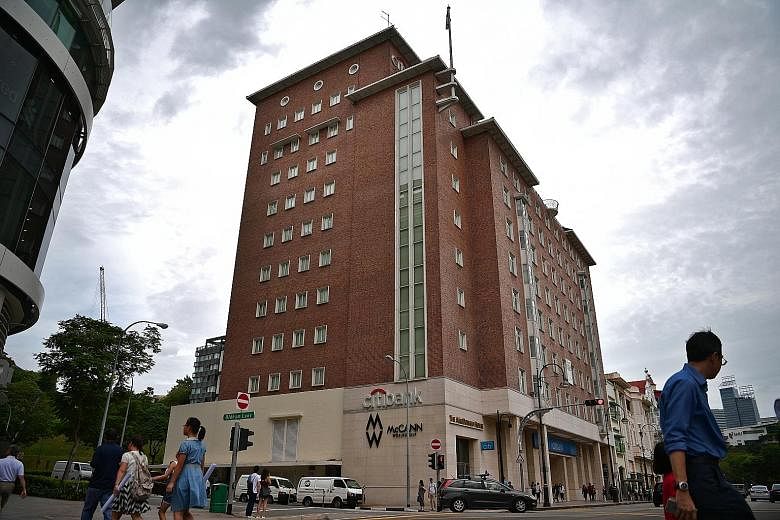It was a remarkable building back in 1965 - it was the first high-rise building in Orchard Road, the first multi-storey office space for international companies and the first fully air-conditioned building here.
It was like the World Trade Centre in New York City - it became a target for terrorists, given its iconic status and central position in town.
But more than 50 years on, MacDonald House still stands today, having survived one of Singapore's worst terrorist attacks.
On March 10, 1965, as Hong Kong and Shanghai Banking Corporation (HSBC) employees milled about rounding up the accounts seven minutes after banks closed at 3pm, an explosion rocked the building.
The 11kg bomb, set with a timing device by two rogue Indonesian marines, was detonated near the lift on the mezzanine floor of the building.
Its impact ripped through the lift and walls of the 10-storey building, as a mass of rubble collapsed into the bank on the ground floor.
The bombing was the worst of the 37 bombings in Singapore during the Indonesian Confrontation or Konfrontasi, waged as a result of Indonesia's opposition to Singapore's merger with Malaya.
It killed three people and injured 33. The chaos extended to the outside - shattering windows and damaging shophouses and cars within 100m of ground zero. The two marine saboteurs were eventually arrested and hanged on Oct 17, 1968.
Today, the restored MacDonald House stands tall with its white marble and red brick facade, its dark chapter receding into the background as crowds pass by from Dhoby Ghaut MRT to Bras Basah.
The inner walls and exterior pillars destroyed in the bombing have since been restored.
In 2003, the building was gazetted as a national monument and a plaque briefly detailing its history was put up near the front doors.
Built in 1949 and designed by architect Reginald Eyre of Palmer and Turner, it was the first large-scale office building built in the post-war era and its main tenant was HSBC.
In 2003, HSBC sold the building to an Indonesian investor, but some elements still serve as reminders of its occupancy, such as the large plaque on the building's facade, embossed with the bank's logo, which comprises the United Kingdom's royal coat of arms above an image of three men and two Chinese junks. Two balconies flank the logo, each bearing an HSBC monogram.
CitiBank and international advertising firm McCann Worldgroup are now the building's main tenants.
Public relations consultant Valerie Ong, 27, who works in the building, said: "I vaguely know about its history; we learnt about the bombings in school.
"Also, when taxi drivers pick me up from the building, there's always a bit of a history lesson that happens and we'll chat about the bombing and the building's heritage."
The building was named after Sir Malcolm MacDonald, the British Commissioner-General for South-east Asia from 1948 to 1955, who was popular with the locals as he often interacted with them.
Heritage conservation expert Johannes Widodo said: "It became one of the prime targets for a terrorist attack in 1965 due to its iconic position at the heart of Singapore, very close to the Istana as the symbol of authority and the Orchard Road commercial district."
The associate professor at the National University of Singapore's School of Design and Environment added: "It may be compared to New York's World Trade Centre." The centre's position and symbolic meaning had made it the main target in the Sept 11, 2001, terrorist attacks on the United States.
In a way, the bombing of MacDonald House had strengthened community resilience, civil defence, voluntarism and unity, he added, and this provided Singapore with the "inner strength and energy" to become an independent nation soon after.
On the 50th anniversary of the attack in 2015, a memorial to the victims of Konfrontasi was unveiled at Dhoby Ghaut Green, across from MacDonald House.
Assistant Professor Yeo Kang Shua, an expert on architecture and sustainable design at the Singapore University of Technology and Design, said MacDonald House, like many other buildings of its time, represents society's search for modernity. The building arose on the back of modern industrial processes of that time, such as the ability to process imported marble and resultant products such as fine bricks.
"Most associate the industrialisation of Singapore with the setting up of Jurong Town Corporation. But most forget that Singapore has always been at the forefront of technological advancement in the region. And this building is one such example," he added.
Prof Widodo said the building represented the spirit of modernity.
"Especially with its concrete frame structure, red-brick cladding in Art Deco style, technological innovation, rational and functional organisation of space, and its iconic position at the centre of Singapore.
"It was a highlight of Singapore as a modern-global city, a status that has been the identity of this place since its early history as a cosmopolitan trading port until today."


